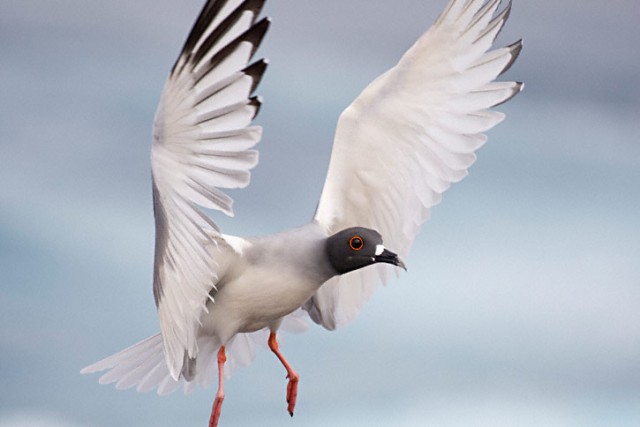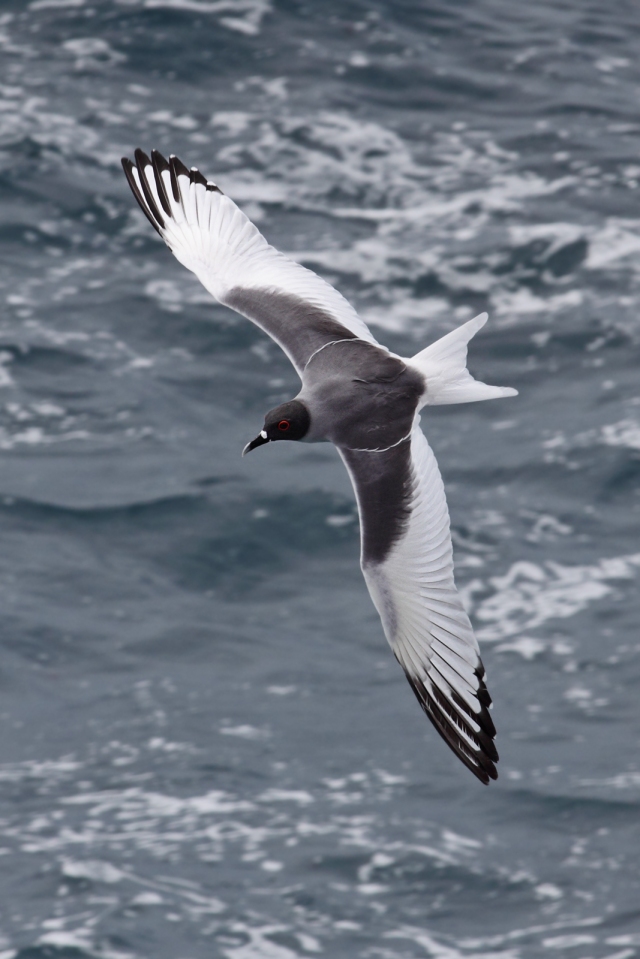The Swallow-Tailed Gull is an equatorial seabird in the gull family, Laridae. it is the “only species” in the genus Creagrus, which derives from the Latin (Creagra) and the Greek (Kreourgos) which means “butcher”, also from Kreas (meat); according to Joblin, it would mean “hook for meat”, referring to the “hooked” bill of this species.
It was first described by French naturalist and surgeon —- Adolphe-Simon Neboux in 1846. It’s scientific name is originally derived from the Greek word for gull (Glaros) and via Latin gull (Laros) and two-tined fork(Furca). It spends most of its life flying and hunting over the open ocean.
The main breeding location is in the Galapagos Islands, particularly the rocky shores and cliffs of Hood, Tower and Wolf Islands, with lower numbers on the other islands. It is more common on the eastern islands, where the water is warmer. It is the only “fully nocturnal” gull and seabird in the world, preying on squid and small fish which rise to the surface, at night, to feed on “plankton”.
The swallow-tailed gull has no structural or plumage differences between the male and the female. In the breeding season, the adult has a black plumaged head and a bright-red fleshy rim around each eye. Outside the breeding season, the head is white and the eye-rim becomes black. It has a greyish upper breast, grey mantle and black wingtips. The mostly-black bill has a contrasting white tip. It breeds from about 5 years old, with pairs frequently staying together from year to year. The nest is made on a small platform, on a cliff, usually less than 10m above sea level, by covering the rocky ground with small pieces of lava, white coral and sea-urchin spines, which prevent the egg from rolling. The female usually lays one speckled egg per breeding attempt. They are “asynchronous” breeders (can breed any time of the year) and follow a nine-month cycle. The egg is generally incubated for 31-34 days. A “chick” takes its first flight at about 60-70 days old, and is fed by the adults until about 90 days, when it leaves the land, possibly with the adults, to live over the open seas.
The swallow-tailed gull leaves the colony as a flock, at dusk, with a great deal of “screaming”. The loudest and most commonly heard call is an alarm referred to as “rattle-and-whistle”, a “gurgling scream” made with head moving from side to side. This call is “contagious”, with the other birds joining in without seing the cause. A loud and rapid “kweek, kweek, kweek” is the greeting call between mates, made with the head and neck curved forward to the ground.
In order to see, while hunting at night, the swallow-tailed gull’s eyes are larger in size and volume than those of other gulls. They also possess a “Tapetum Lucidum” in the back of the eye that reflects light back through the retina, increasing the amount of light available to the photo-receptor cells. A study of melatonin levels of the swallow-tailed gull found them to have no measurable daily melatonin rhythm, whereas a day-feeing gull, that was chosen for comparison, had the expected higher night-time melatonin level for day-active birds. High melatonin levels generally make birds sleepy. It is still unknown whether the melatonin levels are a “cause” or an “effect” of the swallow-tailed gull’s nocturnal activity.
Population trends have not been estimated, but it is not thought to be ” threatened”. The population was estimated to be about 35,000 individuals, when it was last considered in 2004.




